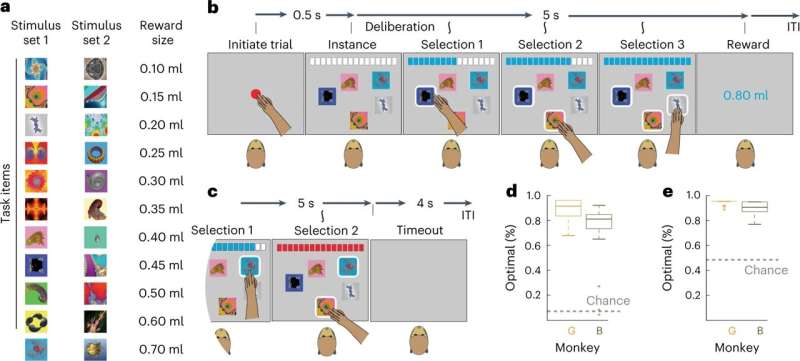This article has been reviewed according to Science X's editorial process and policies. Editors have highlighted the following attributes while ensuring the content's credibility:
fact-checked
peer-reviewed publication
trusted source
proofread
Study shows monkeys are capable of complex deliberation and careful decision-making

A paradigm-shifting study published today in Nature Neuroscience shows that, just like humans, monkeys are capable of complex deliberation and careful decision-making. The study is the first to show that monkeys can think deeply about a problem and consider combinations of factors such as costs, consequences and constraints. In doing so, monkeys can find optimal outcomes rather than impulsively reaching for the first available option.
"Humans are not the only animals capable of slow and thoughtful deliberation," said senior author William Stauffer, Ph.D., assistant professor of neurobiology at the University of Pittsburgh School of Medicine. "Our work shows that monkeys have a rich mental state that renders them capable of intelligent thinking. It's a new paradigm for studying the neurophysiological basis for deliberative thought."
Consider a fundamental question: how do we, as humans, think about what we want? What happens in our brains when we close our eyes and deliberate over complex questions, such as who to spend time with or what to study at school? And are other animals, including monkeys, capable of the same complexity of thought?
Several decades ago, the Nobel Prize laureate Daniel Kahneman, Ph.D., revolutionized the field of behavioral economics with Prospect Theory. In his book, "Thinking Fast and Slow," he postulated that humans employ two distinct systems of thinking: one nearly instantaneous that happens automatically, and the other much slower conscious logical reasoning that requires more mental effort.
Kahneman dubbed the first, effortless, type of thinking as 'fast' and the second as 'slow." Slow, effortful thinking enables us to write music, develop scientific hypothesis and balance our checkbooks.
As it turns out, humans' slow thinking is not unique.
By presenting monkeys with combinatorial optimization problems in what Pitt neuroscientists dubbed the 'knapsack task' and rewarding the animals based on the value of the submitted solutions, researchers showed that monkeys employed sophisticated mathematical reasoning and used efficient computational algorithms to tackle complex problems.
The scientists discovered that the animals' performance and speed of deliberation was dependent on the task's complexity, and that their solutions closely matched those generated by efficient computer algorithms designed specifically to solve the optimization problem.
"Results from this work will contribute neurophysiological evidence to enlighten centuries of discussions about dual process theories of the mind, the structure of thoughts, and the neurobiological basis of intuition and reasoning," wrote Stauffer in an accompanying research briefing.
More information: William Stauffer, Computational complexity drives sustained deliberation, Nature Neuroscience (2023). DOI: 10.1038/s41593-023-01307-6. www.nature.com/articles/s41593-023-01307-6
Journal information: Nature Neuroscience
Provided by University of Pittsburgh




















